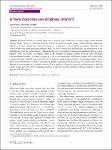Thông tin tài liệu
Thông tin siêu dữ liệu biểu ghi
| Trường DC | Giá trị | Ngôn ngữ |
|---|---|---|
| dc.contributor.author | Anle, Wang | - |
| dc.contributor.author | Martin H., Müser | - |
| dc.date.accessioned | 2023-04-14T08:26:27Z | - |
| dc.date.available | 2023-04-14T08:26:27Z | - |
| dc.date.issued | 2023 | - |
| dc.identifier.uri | https://link.springer.com/article/10.1007/s40544-022-0644-3 | - |
| dc.identifier.uri | https://dlib.phenikaa-uni.edu.vn/handle/PNK/7956 | - |
| dc.description | CC BY | vi |
| dc.description.abstract | Adhesion between an elastic body and a smooth, rigid substrate can lead to large tensile stresses between them. However, most macroscopic objects are microscopically rough, which strongly suppresses adhesion. A fierce debate has unfolded recently as to whether local or global parameters determine the crossover between small and large adhesion. Here, we report simulations revealing that the dependence of the pull-off force Fn on the surface energy γ does not only have two regimes of high and low adhesion but up to four regimes. They are related to contacts, which at the moment of rupture consist of (i) the last individual Hertzian-shaped contact, in which is linear in γ, (ii) a last meso-scale, individual patches with super-linear scaling, (iii) many isolated contact patches with extremely strong scaling, and (iv) a dominating largest contact patch, for which the pull-off stress is no longer negligible compared to the maximum, microscopic pull-off stress. | vi |
| dc.language.iso | en | vi |
| dc.publisher | Springer | vi |
| dc.subject | stickiness criterion | vi |
| dc.title | Is there more than one stickiness criterion | vi |
| dc.type | Book | vi |
| Bộ sưu tập | ||
| OER - Kỹ thuật điện; Điện tử - Viễn thông | ||
Danh sách tệp tin đính kèm:

